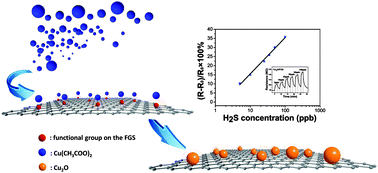
Stable Cu2Onanocrystalsof around 3 nm were uniformly and densely grown on functionalizedgraphenesheets (FGS), which act as molecular templates instead ofsurfactantsfor controlled nucleation; the distribution density ofnanocrystalscan be easily controlled by FGS with different C/O ratios. The nanocomposite displays improved stability of the crystalline phase in wet air, which is attributed to finite-size effects that the high-symmetry crystalline phase is to be more stable at smaller size. Meanwhile, we conjecture that the oxygen adsorbed on the interfacial surface prefers to extract electrons from FGS, thus the interfacial bonding also makes a contribution in alleviating the process of corrosion to some extent. More importantly, the Cu2O–FGS nanocomposite based sensor realizes room temperature sensing to H2S with fantastic sensitivity (11%); even at the exposed concentration of 5 ppb, the relative resistance changes show good linearity with the logarithm of the concentration. The enhancement of sensitivity is attributed to the synergistic effect of Cu2O and FGS; on the one hand,surfactant-free capped Cu2Onanocrystalsdisplay higher surface activity to adsorb gas molecules, and on the other hand, FGS acting as conducting network presents greaterelectron transferefficiency. These observations show that the Cu2O–FGS nanocomposite based sensors have potential applications for monitoring air pollution at room temperature with low cost and power consumption.
Full Article:http://pubs.rsc.org/en/Content/ArticleLanding/2013/NR/c2nr33164k



